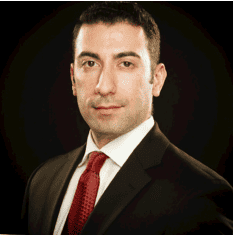
Josh Barkhordar, director, head of sales
What more needs to be done to encourage institutional involvement in the digital asset space?
Josh Barkhordar: The regulatory landscape over the last several months has been very convoluted. We need more regulatory clarity. This aspect is certainly one of those factors that institutions are looking for in order to make further inroads into the space. There are pockets within the digital asset ecosystem where inroads are being made, primarily with respect to tokenisation. But there are other areas in the capital markets, for example, where we do need further regulatory clarity and we’ve seen a change in the trend where market makers, proprietary firms and trading firms are moving their businesses offshore as a result of the regulatory landscape that we have here in the US.
Gordon Grant: We hope to see what I would consider to be proper prime services platform offerings, including a FX PB, equity PB style solution. This has been a long time coming for crypto. It still doesn’t really exist yet where you can trade with one counterparty, and you can settle and clear your risk centrally on a bilateral basis.
We should also try to get some convergence between cash settled product pricing and liquidity with established crypto native coin settled product. A spot-based ETF would potentially do that. But as of now, cash settled products like the CME exchange crypto options live in a totally different universe from coin settled products that trade on some of the other exchanges like Deribit for instance. Again, as a harmonising feature, we need to get some introduction of globally accessible perpetual futures markets. Perpetual futures are a main stay of the crypto ecosystem in terms of linear risk management, but essentially there is highly limited access for North American players in that space, if any at all. You tend to need to be based outside of the US and be a non-US person in order to access perpetual futures. Without that, the North American market and certain developed markets sit in a sandbox by themselves while the rest of the world has access to those. That leads to greater fragmentation.

Gordon Grant, managing director, trading and sales
How important is robust governance and regulatory oversight for the attractiveness of digital assets at an institutional level?
Gordon Grant: The regulatory environment is fragmented and so is the product space. I would say governance and oversight in the North American market is probably more than sufficient in terms of stringency. It happens typically by enforcement, but we have it. If anything, governance suffers from insufficient clarity. We need to see a re-equilibration there. North American compliance professionals might argue that in the rest of the world, there’s relatively less stringency, but there’s actually much greater regulatory clarity. If you talk to a regulator in Singapore or Hong Kong, or increasingly, Dubai, they have an approach that says ‘this is a security, this is not a security, this is what you can do with that, this is what you cannot do with this’. There is a balance that we need to arrive at, but certainly for North American market, I would say excessively stringent oversight and governance, in terms of comparing it to how much clarity you get for that stringency, there’s more of a healthier balance in the eastern hemisphere.
I would also say that securities-based oversight of digital asset products hasn’t been well received by participants in this system. If you’re a securities regulator trying to force everything into being a security under some kind of abstruse arcane test, is this discussion about expectation of resale for a future profit relevant? It’s difficult to use that as the sole sufficient test and I think that that approach has been tough. Whereas commodities-based oversight and governance has been better received. It’s generally thought of as having more of a balance between stringency and clarity.
We also need more cohesion. You’ve got different kinds of governance and oversight in a prismatic sense, and depending on what lens you look through, you’re going to see different things, which is also not good. You want to be able to take a look at an ecosystem if you’re an equity investor or if you’re a fixed income investor and be able to know everything about this system from operations, booking, trading, reporting requirements and taxation. In crypto, we don’t have that yet and we need to get there.

Ravi Doshi, director, head of trading
How have regulatory events surrounding certain players altered the way cryptocurrencies are traded?
Ravi Doshi: I would point to the fact that spot trading volumes are down precipitously and there is significantly less liquidity in the markets and this is because of these regulatory events. Due to the SEC regulating by enforcement and there being a lack of clarity as to what you can and can’t trade, we have seen very large market participants leave the market entirely. Now they’re just on the sidelines waiting for clarity to re-enter at some point in the future. We have also seen very large market makers who control the large percentage of the volumes on exchanges move their teams offshore entirely. Then you have a firm like ours, where we’ve done a bit of a hybrid solution where we are now trading fewer assets because we don’t feel comfortable trading as many of the long tail crypto coins that we think could now be deemed securities. We have cut the number of coins that we’re willing to trade and then we’ve also made sure that we have more and more presence offshore. Between those things, it has really changed the structure of the market and liquidity has dried up significantly because of it.
How is the type of firm interested in trading crypto changing, if at all?
Josh Barkhordar: As we speak to our institutional clients today across the crypto native segment and across the traditional segment, we’re finding that many of the traditional players like the hedge funds and the asset managers are primarily working with firms that are licensed and regulated, so they are taking a much more careful and tactical approach to the kind of parties they work with. However, in this juncture right now and in this regulatory landscape, when the traditional players are carefully coming into the space and taking a more tactical approach, the native players and ultra-high net worth client segments are more aggressive about trading digital assets, especially with crypto native players like Genesis for example. The crypto native players, the ultra-high net worth clients and the miners for example, are more active in the space right now. Although I think that the greatest potential is probably withthe hedge fund and the asset manager clients. The banks will eventually step in to service their buy-side clients when the buy-side really makes a further push into the space and we probably expect that to happen during the next bull cycle.